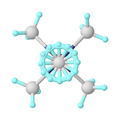Crystallographic disorder
Topic: Physics
 From HandWiki - Reading time: 1 min
From HandWiki - Reading time: 1 min
Short description: Presence of isomers with identical centers of mass in a crystal
In X-ray crystallography, crystallographic disorder describes the cocrystallization of more than one rotamer, conformer, or isomer where the center of mass of each form is identical or unresolvable. As a consequence of disorder, the crystallographic solution is the sum of the various forms. In many cases, the components of the disorder are equally abundant, and, in other cases, the weighting coefficients for each component differ. Disorder can entail a pair or several components, and usually arises when the forms are nearly equal in energy and the crystal lattice is sufficiently spacious to accommodate the various components.
Structure of pentamethylmolybdenum, Mo(CH
3)
5, showing 4-fold disorder of one methyl group.[1]
References
- ↑ Beatrice Roessler; Sven Kleinhenza; Konrad Seppelt (2000). "Pentamethylmolybdenum". Chemical Communications (12): 1039–1040. doi:10.1039/b000987n.
 |
Licensed under CC BY-SA 3.0 | Source: https://handwiki.org/wiki/Physics:Crystallographic_disorder5 views | ↧ Download this article as ZWI file
 KSF
KSF

